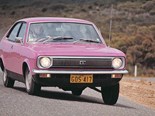Morris 1100 - Buyer's Guide



|
Riding on brilliant hydrolastic suspension and able to seat six, BMC's popular little 1100 was once a household name
From Unique Cars #319, Jan 2011
MORRIS 1100
Alec Issigonis’s Mini changed the automotive world, but cheeky looks and compact dimensions didn’t fulfil the needs of many potential customers. Before the first Mini even reached Australian roads, BMC’s development team was working on a car that would transplant its front-wheel drive, transverse-engined design principles into a larger four-door version.
With a wheel at each corner and exceptional space utilisation, BMC’s 1100 was intended to comfortably accommodate five people. The 1098cc A-Series engine developed only 37kW but low gearing ensured the 1100 had decent acceleration.
While it looked to be a conventional design, under the 1100’s compact body lurked a suspension system unlike anything seen before on a British car, and surpassed only by Citroen’s hydro-pneumatic DS.
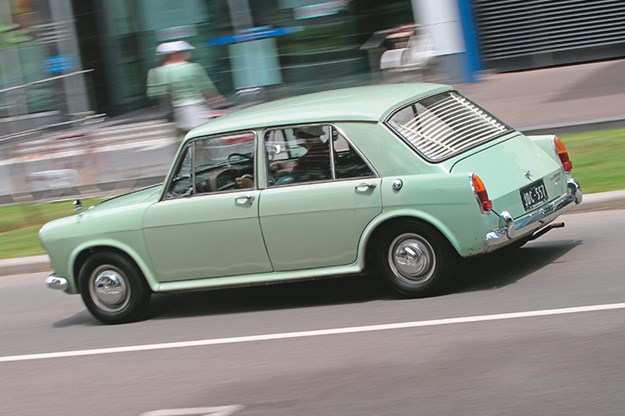 It only had a top speed of 120km/h but Morris 1100 could be flung into corners
It only had a top speed of 120km/h but Morris 1100 could be flung into corners
Design of the ‘Hydrolastic’ suspension system is attributed to bicycle entrepreneur Alex Moulton, working in conjunction with Issigonis, and was inspired by Citroen’s 2CV. Using interconnected displacer units and an alcohol-based fluid, the system allowed wheels that encountered bumps to deflect while minimising body movement and road-shock transmission.
| Buyer's Guide: Leyland Mini Clubman
Austin, Morris and MG versions of the 1100 appeared on British roads late in 1962, but it wasn’t until February ’64 before the model – badged here only as a Morris – was released in Australia.
The intervening months were spent trialling a selection of UK-build cars to ensure that local versions coped with our harsh and hotter driving environment.

Changes included upgraded dust sealing, body strengthening and improved ventilation. There was also that most Australian item of automotive accommodation – a bench front seat – that allowed six occupants to be squeezed in. Cop that, Holden! BMC’s diligence was rewarded less than a year later when the 1100 was named Wheels magazine’s 1964 Car of the Year, and by 1966, more than 50,000 had been sold here.
In Britain, 1100 fever had permeated BMC’s entire range, with Riley, Wolseley and even Vanden Plas versions hitting the market during 1963-65.
| 2019 Market Review: BMC brands
A station wagon was available as well and one soared to international television fame as recipient of a "damned good thrashing" from Fawlty Towers’ branch-wielding Basil.
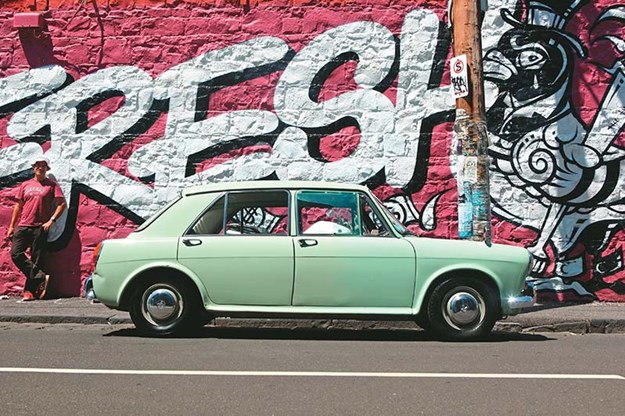 Owner Byron with his cool Porcelain Green Morrie. Colour only available 1964-65
Owner Byron with his cool Porcelain Green Morrie. Colour only available 1964-65
Engine capacity increased in 1967 to 1275cc and UK market cars were renamed the 1300. In Australia, however, the designation was held in such regard that larger-engined local cars simply carried 1100 S badging. The more powerful 47kW engine added a mere $75 to the basic car’s $1999 list price and an automatic transmission became optional.
But BMC in Australia could almost have used ‘When You’re On A Good Thing, Mess With It’ as a corporate motto.
In the search for improved performance as a response to growing Japanese competition, BMC introduced an overhead-camshaft 1.5-litre engine and the unique Nomad station wagon.
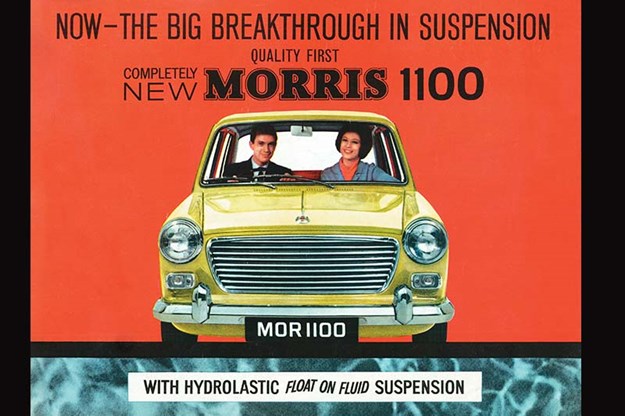
The Nomad body was developed at BMC’s Longbridge factory alongside the 1800-based Austin Maxi, but took almost three years to reach production.
Announced in mid-’69 in conjunction with the more powerful 1500 sedan, manual versions were bugged by problems with their cable gear linkage, which promoted a recall and blighted the reputation of an otherwise worthy design.
Just a year before the model’s demise, a five-speed ‘O/D5’ version of the manual 1500 sedan was launched. It was meant to follow the lead of the British-market 1300GT and be designated 1500GT, but the idea was abandoned due to fears about the effect on insurance premiums.
Both the 1500 and Nomad ended production in late-’71 and were replaced in Australia by the ill-fated Marina.
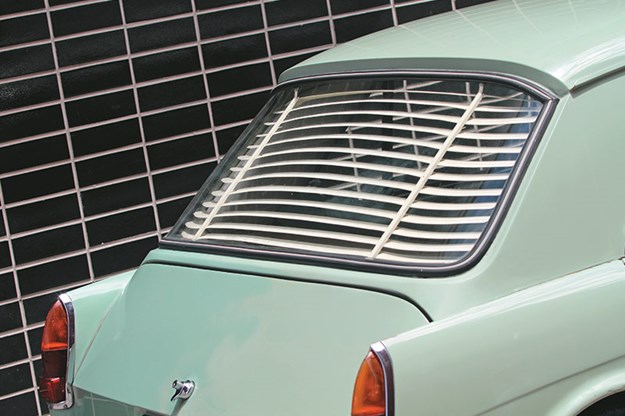 Farina styling followed BMC trends for 1962 with MGB-style taillights
Farina styling followed BMC trends for 1962 with MGB-style taillights
On the road Stepping straight out of my grunty Triumph 2000 into a dealership’s ‘courtesy’ 1100 wasn’t an optimal introduction to the marque, but the orphaned Morris and I hit it off immediately.
This one was ivory with obligatory red vinyl bench seats – slightly worn and a little flat on the driver’s side as I recall, but it had seat belts and a working radio and was definitely preferable to the bus.
Best of all, courtesy cars can be just as quick as rental cars but without the big insurance excess. Accordingly, every tasty-looking bend was taken at tyre-howling pace – the racket diminished once a few psi were added – and gears shifted only when the poor little A-Series engine was gasping for mercy. Usable maximum speed was all of 120km/h, but once wound up to peak revs, the 1100 revelled in its work.

Most noticeable was outstanding grip and refusal of the Hydrolastically-suspended body to roll by more than a few degrees when flung into tight corners. I had spent many hundreds on Koni shocks and fat tyres to make the Triumph behave with similar composure.
Front disc brakes weren’t really warranted in a car weighing 860kg, but BMC needed to maximise its appeal in a market where the 1100 would encounter competition from larger, more conventional models – including the Ford Cortina and Vauxhall’s Viva. Pedal pressures are high as there’s no assistance but for a 1960s car, the 1100’s stopping power is exceptional.

Performance figures for a 1.3-litre 1100 S manual tested by Wheels in 1967 show a six-second improvement in 0-96km/h acceleration and a 15km/h boost in top speed on the original 1098cc car.
You can fit six adults into an 1100, although the one alongside the driver straddles the gear lever so you need to be well-acquainted. The boot is sensibly sized for a car of this size and a 39-litre fuel tank allied to 8.5L/100km consumption will deliver five hours of highway running between refills.
The later 1500 and Nomad were more sophisticated and practical, with five-speed cars delivering relaxed highway performance compared to high-revving earlier models.
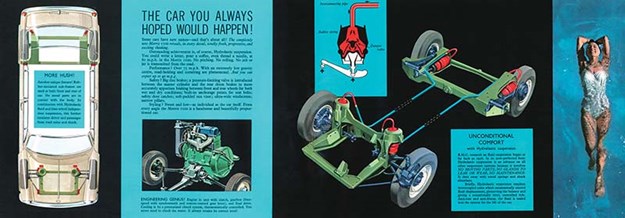
BUYING
The major issue for hopeful owners is finding a suitable car. With more than 90,000 sold here, plus around 25,000 1500s and Nomads, you’d imagine at least a few thousand should survive. Sadly for the impressive 1100, and less so for the others, only a few hundred of all versions are thought to exist in usable condition.
Rust and suspension problems accounted for the vast majority and lots of reasonably good survivors have been dismantled to ensure better-quality cars can be maintained.
When compared to the smaller and more common Mini Deluxe, Morris 1100 values remain extremely low.
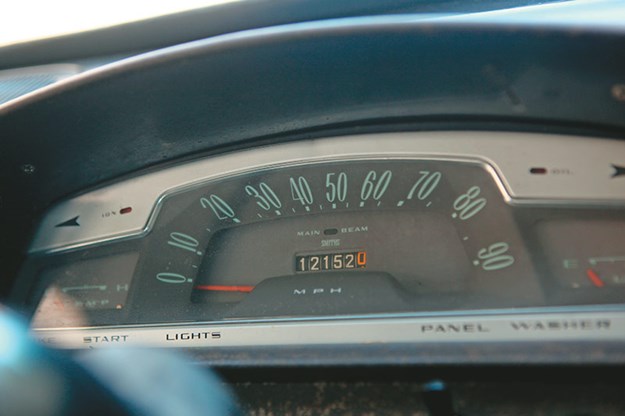 Pastel-green numerals and orange needle only for ’64; scripts for start, lights and what have you unique to Aussie 1100
Pastel-green numerals and orange needle only for ’64; scripts for start, lights and what have you unique to Aussie 1100
According to feature car owner Byron Mathioudakis, however, interest in the 1100 is growing and values of good cars have soared in recent years.
"Back in 2001, even a really good one would cost less than $2000. but ten years later it's hard to find anything worthwhile below $3000 and quality cars are worth around $5000".
Spend around $2000* on an 1100 in usable but tatty condition, with $3500* buying a car that’s good both mechanically and cosmetically. Up to $7000* should buy an outstanding 1100 S manual or a decent example of the rarer MG or Vanden Plas cars.
The latter with its leather and timber interior has been offered fully restored at more than $20,000*.
[*Prices as at 2011]
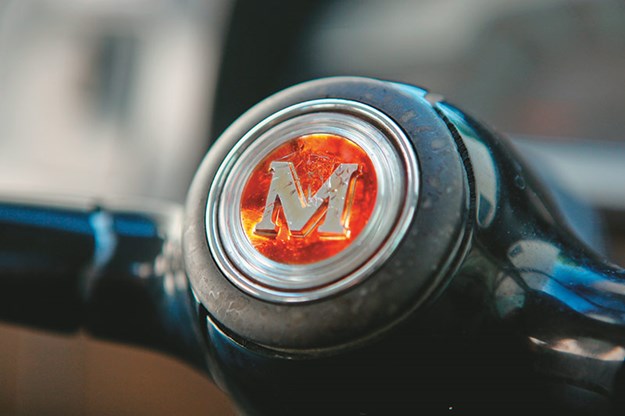
Automatic 1300s and Nomads can be a real risk as repairing transmission problems can cost more than the car is worth. Hardest to find are Luxury-Pack O/D5 1500 sedans.
MORRIS 1100 OWNER - Byron Mathioudakis
Byron Mathioudakis is an unashamed 1100 admirer who has owned two over the past nine years, including one just sold that was bought for parts but was "just too good to wreck".
According to Byron, many owners he encounters first came into contact with the cars as children and for decades had harboured ambitions to own one. "They really are the template for the modern, three-box medium sedan," he said. "Even after almost 50 years, they are very usable cars and keep up with traffic quite easily".
Byron’s Porcelain Green 1100 came into his hands via the grand daughter of the car’s original owner and was in need of some TLC.

"She inherited the car in the early 1990s and drove it for a while but it had been off the road for almost 10 years when I got it and needed some work," he recalled.
"I had to get some engine work done, replace one suspension displacer, the rear drums, and clutch cable but all of that cost me less than $3000." – CC
BUYER'S CHECKLIST
BODY & CHASSIS
Much-vaunted ‘Rotodip’ rust protection applied to these cars from new seems to have failed spectacularly as they aged. Sills, door skins and window surrounds are obvious areas of rust attack but hidden rot is even more critical to a car’s survival. Hoist inspection is essential to check sub-frame mounting points, firewall and floors, and especially the boot. Rust at these locations will most likely be uneconomical to fix. Some new panels are available and club sources or swap meets can provide used steel, glass and chromed parts at sensible prices. UK suppliers offer items including bumpers, door skins and genuine inner mudguards.
ENGINE & TRANSMISSION

The A-Series engine is inherently durable, so smoke, valvetrain clatter, or overheating are signs that work and expenditure will be needed. On the plus side, all mechanical parts should be available and affordable. Use of the recommended lubricant in the engine/manual transmission unit is essential. Gearbox bearing noise can become unbearable and worn synchromesh produces crunching downshifts. Clutch problems can be due to worn master and slave cylinders. Jerky downshifts and slow engagement from an automatic indicate costly problems looming.
SUSPENSION & BRAKES
Clattering from the driveshaft constant velocity joints means imminent replacement but reconditioned joints should be available. Get down low to ensure there is equal space between each tyre and wheel arch. These cars normally sit slightly higher at the front but noticeable inconsistencies point to problems with the Hydrolastic system. Replacement displacer units are available but repairs require a specialist with the equipment necessary to recharge the system. Brake rotors are affordable and even replacement front calipers and new master cylinders are available.
INTERIOR & ELECTRICS
 Unlike Pommy 1100s, Aussie cars had a three-seat front bench, but centre passenger straddled the shifter
Unlike Pommy 1100s, Aussie cars had a three-seat front bench, but centre passenger straddled the shifter
Worn vinyl can be replaced by a trimmer but be cautious of a collapsed seat structure that will entail a trip to the wreckers in search of a replacement.
Check that the front seat moves easily on its runners. The indicator stalks in all early BMC cars were flimsy so ensure it hasn’t been glued into the column. On Nomads, test the rear seat mechanism and that the hatch supports will still hold the rear door open.
MORRIS 1100/1500/ NOMAD (1964-72) Specs
Number Built 810,000 (Morris only), 94,000 Australian cars (approximately)
Body steel, integrated body/chassis, four-door sedan, three- and five-door wagon
Engine 1098cc/1275cc OHV in-line 4cyl (1100/1100S), 1485cc OHC in-line 4cyl (1500); single downdraft carburettor
Power 47kW @ 5500rpm*
Torque 94.5Nm @ 2500rpm*
Performance (1100 S) 0-96km/h – 16.5sec
0-400m – 20.2sec
Transmission 4/5-speed manuals, 4-speed automatic
Suspension independent with wishbones and displacer units (f); trailing arms and displacer units with anti-roll bar (r)
Brakes disc/drum
Tyres 5.50 x 12 or 6.20 x 12; crossplies
Contact Morris/BMC clubs in all states www.elevenhundred.com
* 1100 S
Unique Cars magazine Value Guides
Sell your car for free right here
Get your monthly fix of news, reviews and stories on the greatest cars and minds in the automotive world.
Subscribe

.jpg)











